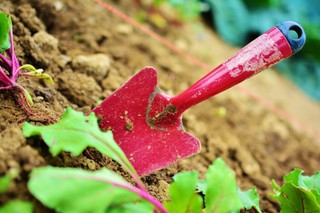How to sterilize soil: The ultimate guide for every treatment

Repeatedly using the same garden soil or potting mix over and over again can lead to a buildup of weed seeds, fungal spores, harmful pathogens, and other detrimental garden pests. If you opt to reuse your soil continuously instead of replenishing it, it’s in your best interest to periodically sterilize it. This provides a clean, uncontaminated growing substrate for your plants.
What is soil sterilization?
Sterilizing soil is a process that has been done in commercial greenhouses, and by agricultural producers for quite some time. Greenhouses perform it to save them from replenishing their potting soil every year; farmers sterilize their fields when they have pest or disease problems in high-dollar crops – sterilization is cheaper than treating problems or potentially losing an entire crop.
Soil sterilization plays a bigger role when soil is used for seed germination, the propagation of stem or shoot cuttings, and the transplanting of juvenile plants. These growing conditions increase the susceptibility of damping off and other plant problems if the soil is infected with mold, fungal spores, or other harmful organisms. Soil sterilization is less critical when only growing mature plants, but is still beneficial when performed periodically.
There is a mix of opinions on whether or not soil sterilization is necessary or even good practice for homeowners and small scale gardeners to follow.
Some believe it isn’t worth the time invested for what little benefits are seen; some are concerned it negatively impacts the beneficial aspects of the soil, wiping out good bacteria and microorganisms; others believe it’s critical for good plant growth, especially when gardening in containers or raised beds with potting mixes.
The truth is, pros and cons exist, depending on the method of soil sterilization used. Negative ramifications can be minimized when procedures are carefully followed.


The enthusiast's guide to herbs
We’re proud to present our new e-book, The Enthusiast’s Guide to Herbs! Learn everything you need to know about growing and caring for herbs indoors, including in-depth info cards for the 35 most commonly grown herbs.
Click the link below to find out more!
Ways to sterilize soil
There are two basic methodologies used to sterilize garden soil and sterilize potting soil: chemical treatments and heat treatments.
Chemical Treatments
This practice is utilized on a larger scale, typically by commercial operations because of the cost and hazards involved with the process.
On the upside, chemical sterilization treatments are easy to use and application can be done quickly, even when sterilizing a large amount of mineral soil or potting soil.
There are some major drawbacks though, which is partly why chemical treatments aren’t as popular, especially with homeowners.
-
Chemical applications pose a health and safety risk to the person doing the application, and those in close proximity.
-
Modern chemicals have a very narrow range for which effects will be seen. In most cases, a single chemical will only eradicate one of a slight few diseases or pests.
-
After application, there is a quarantine period before the soil can be used again. This is necessary to allow the chemicals to degrade fully or be flushed out of the substrate.
-
If not applied properly, residues may linger in the soil and potentially be taken into the plants through the roots, concentrating in plant tissues.
-
Long-term use of chemicals can increase the resistance of a disease or insect pest to a given treatment, rendering it less effective or even completely ineffective over time.
Heat Treatments
Due to many of the negative aspects of chemical sterilization treatments listed above, heat treatments are much more commonly utilized by home gardeners.
Heat treatments raise the temperature of the soil through steam or direct, dry heat to a threshold where the harmful organisms, fungal spores, weed seeds, etc. are unable to survive, and die. Heat treatment is often called sterilization, but this is a misnomer as the soil isn’t completely sterile at the temperatures induced.
It does kill weeds and pests depending upon the internal temperature reached,[1] and the length of time the threshold is maintained. Most instructions recommend at least 30 minutes at the given temperature to kill specific organisms (see Table 1) in moist soil or potting mix.
Research has shown that even sterilization significantly reduces the population of beneficial soil bacteria, it does not eradicate them completely. After sterilization, certain species such as Pseudomonas and Bacillus, quickly recolonize the soil and their populations reach high levels within a short amount of time.[2] This quick recolonization overrides the initial reduction in populations through sterilization.
| Table 1. Target Temperatures for Soil Sterilization of Moist Soil | |
| | |
| Target Temp | Organisms Killed when Temp Sustained for 30-minutes |
| 120℉ | water molds (oomycetes) |
| 145℉ | most plant pathogenic fungi, bacteria, and viruses, worms, slugs, centipedes |
| 160℉ | plant pathogenic bacteria, soil insects |
| 180℉ | weed seeds |
| 212℉ | heat resistant plant viruses and weed seeds |
Heat treatments can be harmful if the internal temperature of the substrate is allowed to get too high. Excessive soil heating may increase the chance of phytotoxicity due to soluble salts, manganese toxicity,[3] and toxic organic compounds.
Soil mixtureshigh in readily decomposable organic matter (manure, leaf mold, compost) are more likely to give injury when exposed to excessively high temperatures than mineral soils or potting mixes where the organic matter has completely broken down.
Supplies needed for home soil sterilization
Depending on the method you choose to use, your supply list will vary slightly. Overall the following items are things you already have in your home.
- Baking pans or other heat-proof containers.
- A thermometer capable of reading upwards of 200℉. Meat thermometers work well since they can be inserted into the center of a mass of soil, and are easy to clean when you are finished using them.
- Plastic wrap or aluminum foil.
- Zip top bags.

Methods to heat sterilize your soil
Choosing which method to steam or heat sterilize your soil is highly dependent on the amount of substrate you are working with, and how quickly you want the process done. The four common methods of heat sterilization different based on their heat source: boiling water/steam, a home oven, a microwave, or natural energy from the sun.
Solarization
Using the natural heat of the sun is a common way to sterilize large amounts of soil, especially entire gardens or fields. The basic principle with solarization is soil is covered with layers of plastic and left to absorb the rays from the sun, raising the temperature over a period of time to kill off problematic pathogens, weed seeds, and pests.
Sterilization through solarization can take place in a couple of different ways. The methods produce the same results; which one you choose is a matter of preference and budget.
-
Large scale gardens or fields are covered with plastic to trap the sun’s energy.
-
Larger quantities of soilless potting mixes are spread between a bottom and top layer of plastic to trap the solar energy.
-
Smaller quantities of either mineral or potting soil are placed in plastic bags and set in the sun.
Choosing what plastic to use
The type and thickness of the plastic used for sterilization has some distinct advantages and disadvantages.
Clear or transparent plastic is a better choice than black for solarization. Black plastic deflects some of the solar energy instead of trapping all of it as clear plastic does.
Thinner plastic (1 mil) allows for better heating but is more susceptible to tearing by wind or animals. Medium thickness plastic (1.5 to 2 mils) works better where conditions are windy. Thick plastic (4 mils or more) should only be used in small areas.
How to solarize soil
Regardless of which specific method of solarization you are following and which type of plastic you choose, similar basic steps should be followed.
-
Whether working with mineral soil or potting soil from containers, initial prep is important to increase the efficiency of the heat treatment. Start by breaking up all clods and removing litter from previous plants.
-
If you are working with potting soil, lay down the bottom layer of plastic and spread the potting mix evenly over the top, staying at least 6-inches away from the edges of the plastic.
-
Irrigate the substrate until they are slightly moistened. Garden soils should be wetted to a depth of 12-inches.
-
Cover garden soils and potting mixes previously spread out with a layer of plastic. Pull the plastic tightly across the soil surface, securing it with rocks or a layer of soil along the edges. If using plastic bags, fill them with soil and close tightly, setting them in a sunny location in the yard.
-
Four to six weeks of solarization during the hottest part of the year should be sufficient to sterilize the soil. Areas with cooler, windy, or cloudy climates may be upwards of eight to ten weeks of solarization.
It’s believed that many beneficial soil organisms are able to either survive solarization or they recolonize the soil very quickly afterward. Earthworms are thought to move deeper in the soil profile to cooler areas. This results in a sterilized soil that is quickly recolonized with both beneficial soil organisms and helpful earthworms.

Boiling water or steam
Steam is a great way to efficiently sterilize your soil. It can be done with or without a pressure cooker. If using a pressure cooker be sure to follow all of the manufacturer’s safety precautions.
Pressure cooker method
-
Fill the pressure cooker with a couple of cups of water and insert the rack into the cooker.
-
Set heat-proof containers on the rack above the water with no more than 4-inches of soil in each container.
-
Cover each container tightly with foil.
-
Place the lid on the pressure cooker, leaving the steam valve open slightly to allow steam to vent until the pressure begins to build.
-
Adjust the heat source under the pressure cooker, allowing it to build steam.
-
When the steam valve closes, process the soil at 10 pounds of pressure for 15 to 30 minutes.
-
Remove from the heat source and allow the pressure to subside completely before removing the lid.
-
Keep sterilized soil covered with the aluminum foil until it’s time to use.
Non-pressurized container method
-
Set up your steam container by putting an inch or two of water in the bottom of a non-pressure cooker; then place a rack in the bottom of the sterilizing container.
-
Set heat-proof containers on the rack above the water with no more than 4-inches of soil in each container.
-
Cover each container tightly with foil.
-
Place a lid on the container, leaving it cracked slightly to prevent steam from building up.
-
Once the water comes to a boil, allow it to boil gently for 30 minutes.
-
Remove from the heat source and allow the temperature to drop before removing containers.
-
Keep sterilized soil covered with the aluminum foil until it’s time to use.
Oven
Sterilizing soil in your oven works well if you have small to medium batches to process, and it poses less danger than using boiling water/steam or the microwave. Keep in mind though as the sterilization occurs your kitchen will be filled with what may be deemed an unpleasant odor. It’s best to do this when you can open doors and windows for adequate ventilation.
-
Add approximately 3-inches of soil to an over-proof container.
-
Mix in enough water to thoroughly moisten the soil, but not so much that it becomes runny or overly saturated. Too much water will slow down the process substantially. The water is needed to create steam as it is driven off.
-
Cover the tops of the containers with aluminum foil and place in an oven preheated to 200℉.
-
Monitor the internal temperature of the soil with your thermometer. When it reaches 180℉, allow it to “bake” for thirty minutes without opening the oven door.
-
Shut the oven off and allow the soil to cool to room temperature.
Microwave
Using the microwave to sterilize your soil is a good option if you only have a small amount of soil to work with. Carefully inspect the soil before placing it in the microwave to make sure it doesn’t have any metal in it.
-
Place about two pounds of moist soil inside a clean zip-top, plastic bag. The soil shouldn’t be waterlogged or runny but damp enough it holds together in a clump when you squeeze a handful.
-
Leave the top of the bag open and place it in the center of the microwave.
-
Microwave on high until the middle of the soil reaches a temperature between 180℉ and 200℉. The length of time this takes to achieve will depend on how powerful your microwave is.
-
Carefully remove from the microwave, close the top of the bag, and place inside a cooler until the temperature naturally comes back down to the ambient conditions.
Conclusion
Soil sterilization eradicates harmful organisms, weed seeds, and pathogens from mineral soil and potting mixes through chemical or heat treatments. This is advantageous in conditions where soils are used repeatedly to germinate seeds, propagate cuttings, or grow juvenile plants. Providing a “clean” growing environment prevents damping off and encourages strong, healthy growth. A variety of heat treatments can be used by homeowners to cheaply and efficiently sterilize their soil.

Join our email club—get printable info cards free!
Sign up to receive our newsletter and get access to 10 printable plant info cards from our e-book for free. Also receive:
- $4 discount code for our Guide to Herbs e-book
- Semi-weekly plant inspiration & bite-size tips and tricks
Baker, K. F., & Chandler, P. A. (1957). The U.C. System for Producing Healthy Container Grown Plants. University of California, Division of Agricultural Sciences, Agricultural Experiment Station Extension Service. archive.org ↩︎
Gamliel, A., Hadar, E., & Katan, J. (1987). Microbial phenomena related to increased growth response in solarized soils and to monoculture systems. In: Proceedings of the 7th Congress of the Mediterranean Phytopathological Union. books.google.com ↩︎
Fernando, D. R., & Lynch, J. P. (2015). Manganese phytotoxicity: new light on an old problem. Annals of Botany, 116(3), 313–319. doi.org/10.1093/aob/mcv111 ↩︎
